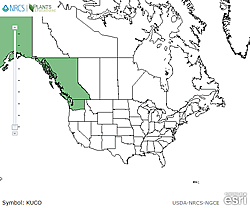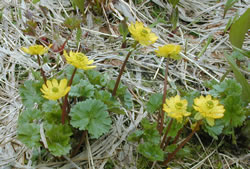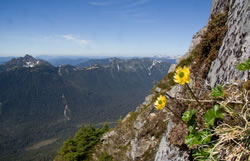Plant of the Week
 Ranunculus cooleyae range map. USDA PLANTS Database.
Ranunculus cooleyae range map. USDA PLANTS Database.
 Cooley’s buttercup, close-up of a flower. Alpine meadow on Mt. Roberts, overlooking Juneau in southeastern Alaska. Photo by Mary Stensvold.
Cooley’s buttercup, close-up of a flower. Alpine meadow on Mt. Roberts, overlooking Juneau in southeastern Alaska. Photo by Mary Stensvold.
 Cooley’s buttercup growing in an alpine meadow on Mt. Roberts, overlooking Juneau in southeastern Alaska. Photo by Mary Stensvold.
Cooley’s buttercup growing in an alpine meadow on Mt. Roberts, overlooking Juneau in southeastern Alaska. Photo by Mary Stensvold.
 Cooley’s buttercup growing in a pocket of soil in the alpine of Mt. Verstovia at Sitka in southeastern Alaska. Photo by Matt Goff.
Cooley’s buttercup growing in a pocket of soil in the alpine of Mt. Verstovia at Sitka in southeastern Alaska. Photo by Matt Goff.
Cooley's False Buttercup (Kumlienia cooleyae (Vasey & Rose) Greene; synonym: Ranunculus cooleyae)
By Mary Stensvold
Grace Cooley, a botany instructor at Wellesley College botanized in coastal British Columbia and southeastern Alaska for five weeks in the summer of 1891. She traveled by steamer and at stops during the voyage she made numerous botanical collections and observations. In 1892, she published her impressions of the country as well as a list of the plants she collected.
While visiting Juneau, she hiked up a mountain behind the town and collected a very unusual buttercup in the alpine meadows near a snow-covered ridge. It turned out that the buttercup was not only unusual, but it was new to science. The buttercup was named in her honor in 1894.
Cooley’s buttercup is a 4 to10 inch tall clump-forming perennial. The flowers of this showy buttercup are about an inch across and distinguished from other buttercups by having numerous (11 to 15) bright yellow petals. Each flower is borne singly on a long leafless stem. The roundish leaves are divided into three parts, with each part being highly dissected with overlapping leaf segments.
The plant is restricted in distribution to the mountains along the North Pacific coast from southern Alaska east and south to western Washington State. Although this is normally an alpine plant, it occasionally grows at sea level in Alaska. This is the first flower to bloom as snow melts from the meadows. The rosettes of yellow flowers and bright green leaves are a dramatic contrast to the newly exposed flattened and brown foliage. In southeastern Alaska, one can relatively easily access and view the plant at Juneau above the top of the Mount Roberts tram, and along the Klondike Highway a few miles south of the Canadian border.

